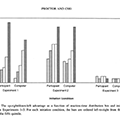Abstract
C.Umiltà’s (1991) proposal that the up–right/down–left advantage for up and down stimuli mapped to left and right responses is due to verbal coding was evaluated. Two approaches were used in separating spatial from verbal codes. The 1st approach used a reaction time distribution bin analysis to examine the effect of response speed on the up–right/down–left advantage. The 2nd approach attempted to create task conditions that would promote either a verbal or visual strategy. Results show that the up–right/down–left advantage increased as response speed slowed down. This finding was interpreted in terms of the dual-strategy hypothesis, which asserts that participants may use the visual or the verbal stimulus code and that, depending on the task constraints, a visual or verbal strategy may prevail. With a visual strategy, no compatibility effect arises. With a verbal strategy, the up–right/down–left advantage emerges.
